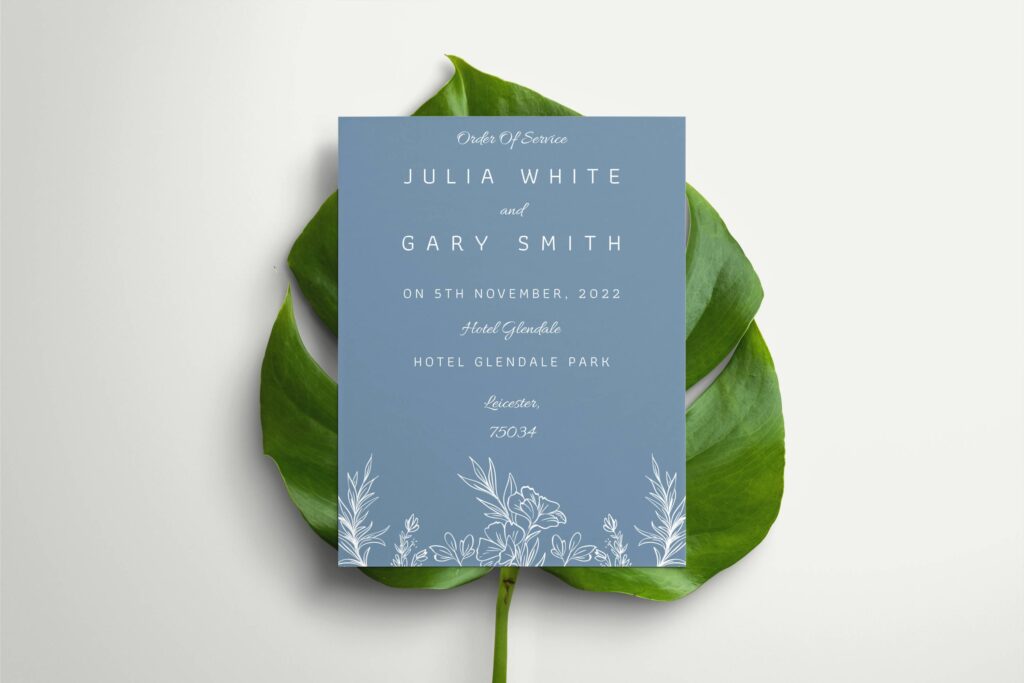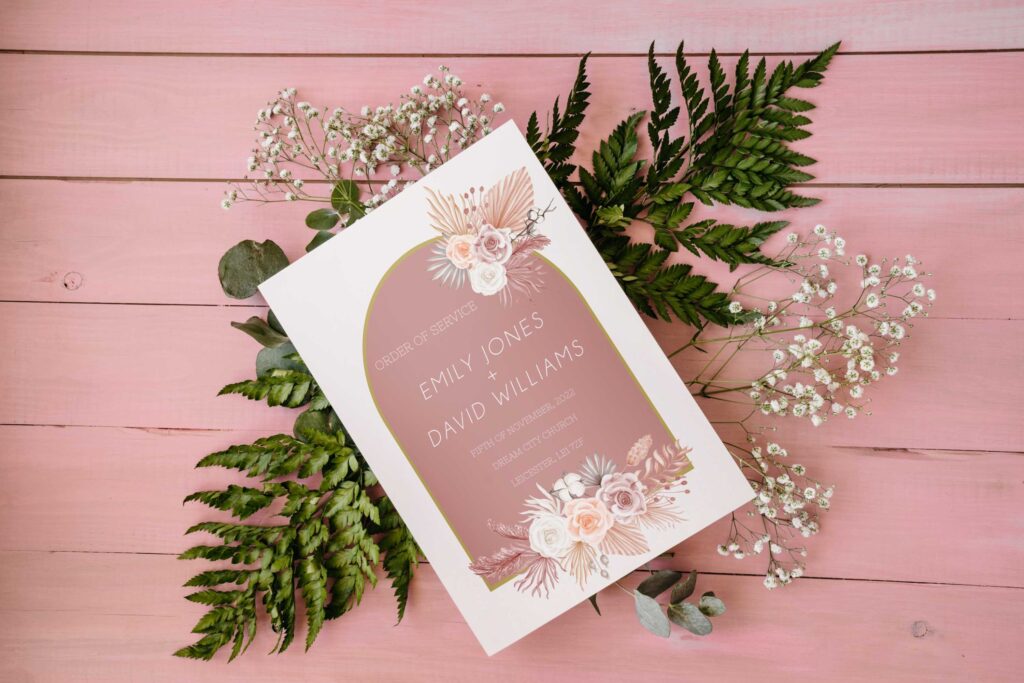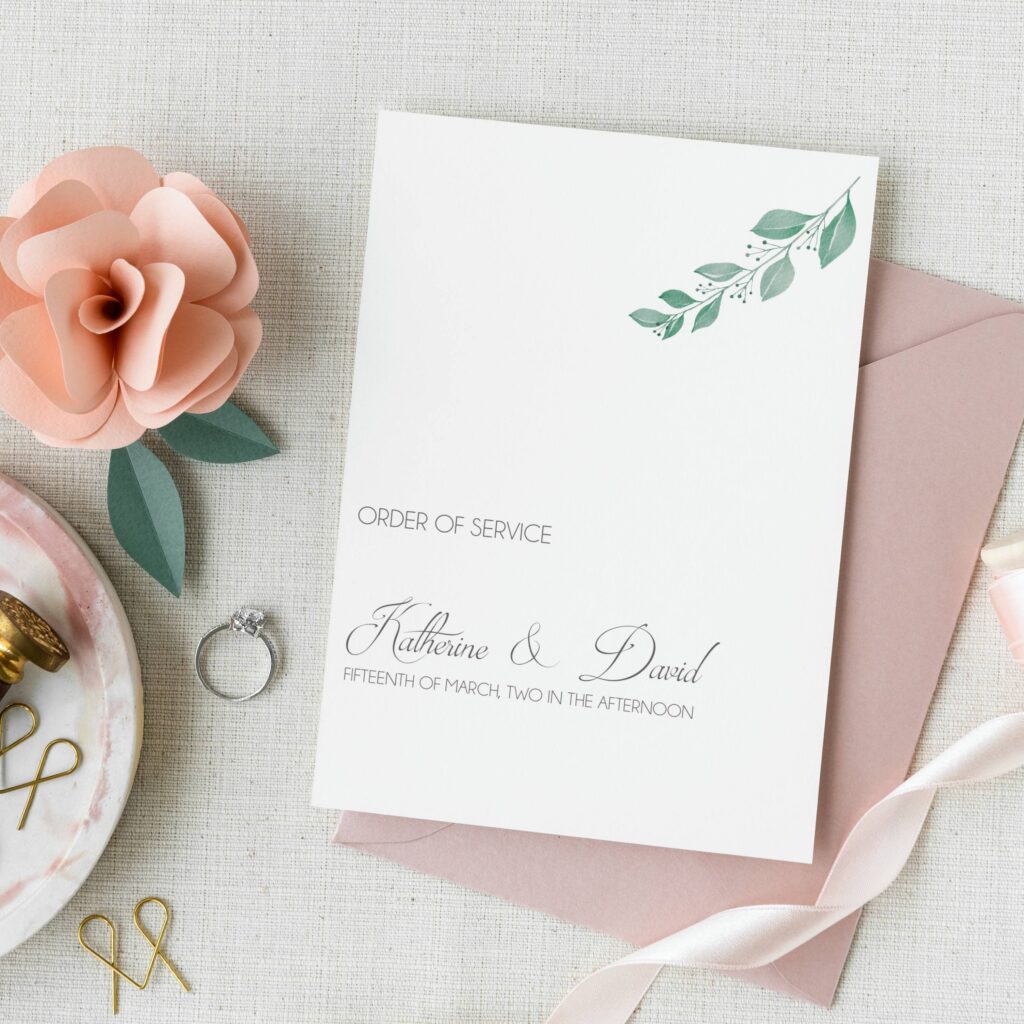What is a wedding order of service, and why is it important?
A wedding order of service is like a guide that shows the plan and details of a wedding ceremony. This essential document includes information about crucial proceedings, such as the processional and recessional, while also spotlighting readings that provide insight into the couple’s shared values. Carefully curated music selections, ranging from the processional to the recessional, set the mood and tone for different parts of the ceremony.
Additionally, the wedding order of service meticulously outlines the exchange of vows, rings, and other symbolic rituals that make the ceremony uniquely personal.
Couples often infuse their distinct preferences, cultural traditions, or thematic elements into the order of service, adding a touch of individuality to the celebration. Including personal touches, like thank-you messages or dedications, expresses the couple’s gratitude to their guests.
Whether presented as a booklet or a printed card, the tangible order of service becomes a valuable tool for guests, helping them follow along and actively engage in the joyous celebration. In essence, creating a beautiful and informative wedding order of service is a vital aspect of wedding planning, contributing significantly to the overall cohesion and enjoyment of the ceremony.

Do you need an order of service for a wedding?
While it is not mandatory, having an order of service for a wedding can be very helpful. An order of service is a detailed document that specifies the timing and key elements of the wedding ceremony. Here’s why having one can be useful:
Guidance for Guests:
It gives guests a clear picture of how the ceremony will proceed, allowing them to anticipate what to expect and when.
Enhanced Participation:
When guests understand the order of events, such as when to stand, sit, or take part in readings, they can actively participate in the ceremony.
Personalization:
Couples can use the order of service to include personal touches such as special readings, quotes, or dedications to make the ceremony more meaningful.
Cultural or religious traditions:
For weddings that include specific cultural or religious traditions, the order of service ensures that guests are aware of and can appreciate and enjoy these aspects of the wedding.

What should be included in a wedding order of service?
The content of a wedding order of service can vary based on personal preferences, cultural traditions, and religious beliefs. The specific details and their arrangement can significantly differ from one church to another. It is advisable to consult with the individual overseeing your marriage service, as they may provide a standard template. However, as a broad guideline and initial reference, here is what typically constitutes an order of service for a wedding.
Welcome:
“Welcome” typically serves as an introductory phase in a wedding ceremony and often comes at the beginning of the wedding order of service. It expresses gratitude to the guests for their attendance and sets a positive tone for the proceedings. The officiant or a selected speaker greets friends and family, says a few words about the significance of the day, and helps set a friendly and welcoming tone for the ceremony. This is known as the “Welcome” segment.
Processional:
What is the order of walking in a wedding ceremony? The “processional” is an important part of a wedding order of service program that happens at the beginning. It’s when the bridal party, including bridesmaids, grooms men, and the bride, walks down the aisle. There’s music playing during this walk, and it shows that the wedding is starting. The “processional” is a special and emotional moment because it means going from being on your own to being committed to someone else. It starts the whole ceremony and gets everyone excited for when the couple says their vows and officially becomes married. It’s like the start of a beautiful love story!
Introduction and welcome:
The “introduction” of a wedding ceremony is when the officiant or speaker extends a warm welcome to all attendees. They may express gratitude for everyone’s presence and explain why the day is important. This creates a warm and positive atmosphere for the remainder of the wedding.
Hymn:
A “hymn” is a song that is frequently sung or played at weddings and contains special words that have a religious or spiritual meaning. During the wedding, guests sing hymns together or are played i the background to celebrate and express joy, love, or gratitude. The ceremony is made even more memorable by this musical moment, which adds a pleasant and significant atmosphere.
Readings:
At weddings, “readings” are when someone, like a friend or family member, reads a special passage or text. These readings may be from religious books, poems, or personal writings. Sharing heartfelt phrases that highlight unity, love, or other significant themes gives the ceremony a lovely touch. The officiant, or person conducting your wedding, may choose to introduce each reader and read, or you may choose to allow the readers to speak freely during their respective readings.
Marriage ceremony:
A “marriage ceremony” is the special occasion where two people officially become a married couple. It includes all the different parts of the wedding, like saying vows, exchanging rings, and getting officially pronounced as a married couple. The couple makes a public commitment to love and support one another for the rest of their lives during the marriage ceremony.
Blessing:
“Blessing” is a special hope or prayer for positive outcomes. It’s customary for a priest or other family member to ask God or a higher power for the couple’s favour and guidance during a wedding. It is a way for them to express their desire for happiness, love, and marital success.
Exchange of Vows:
The special moment is when the couple verbally expresses their promises and commitments to each other. These vows are personal and represent the unique bond and commitments the couple makes to their marriage. This emotional exchange is symbolic, marking the foundation of their union and creating a lasting memory for both the couple and everyone witnessing their love and dedication.
Signing of the Register:
The “signing of the register” occurs when the couple, along with witnesses, officially signs the legal marriage registration. This formal step confirms the legal aspects of their union and is often a required part of the wedding ceremony.
Pronouncement and kiss:
It is the very first introduction of a newly-wed couple by the officiant, both formally and officially. The couple then seals their vows with a very first kiss as “husband and wife,” husband and husband, or “wife and wife.”
Recessional:
The wedding party, including the newly-weds, makes a joyful exit, accompanied by music. The recessional signifies the official conclusion of the wedding ceremony and the beginning of the celebratory phase, such as the reception or post-ceremony festivities.

Where can I find a wedding program order of service template?
You can find all our wedding order of service templates here. If you don’t find the template that you are looking for, please email us or contact us, and we will create a personalized template for you.
How many readings should we include in the order of service?
You have the option of having one or more readings during your wedding ceremony. It is a personal preference, and couples often pick between one or two readings. However, if you want to include more friends and family, you can choose multiple readings to make the ceremony more inclusive and meaningful for everyone present.